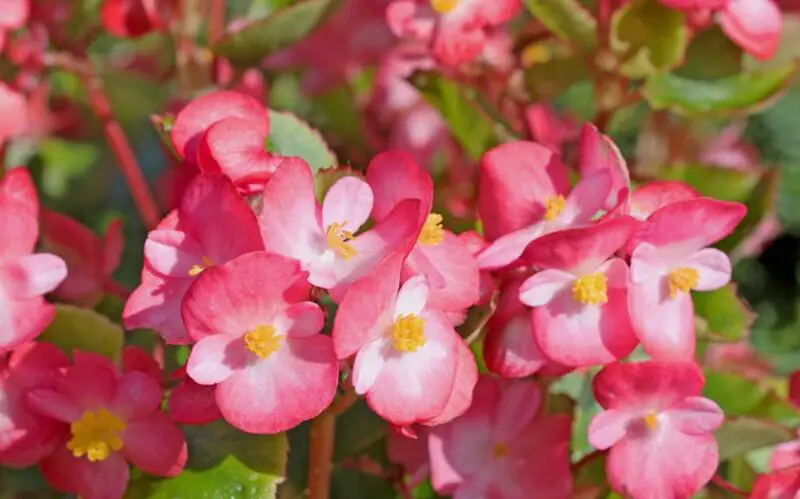Outdoor begonias are usually tuberous or bushy with fibrous roots, as they are the most floriferous. The former can be kept for several years (provided they are protected from frost in the winter), the plant becoming larger and more flowering each year, while the latter are grown as annuals to be thrown away at the first frost.
The begonias are generally frosty except for some perennial species such as Begonia grandis which offers an average hardiness (14°F).
Contents
Where to plant begonias
Plant begonias in planter boxes to be placed on a window exposed to mid-shade. Avoid south-facing, too much sun.
They prefer semi-shade even though some varieties, especially those with bronze foliage, are more tolerant of the sun as long as the soil remains cool. Protect them from drafts that can break their fragile branches.
Begonias appreciate fertile, light, humus-rich, fresh, but well-drained soil because they fear excess water.
When to plant begonias
Begonias are bulbous plants of the summer. You can plant your begonias in planter boxes as early as February, but don’t take them out until the risk of spring frosts (the famous Ice Saints) is over. So, wait until mid-May to take them out, or plant the begonias in the garden beds.
How to plant begonias
The begonia is quite slow to start its vegetation period. Begin as early as March, by placing the tuber on moist and warm (68°F) soil exposed to light. Spray regularly.
When the roots start to develop, pot the tuber by burying it 1 or 2 inches deep, with the concave side of the tuber facing upwards. For outdoor planting or planter boxes, wait until the risk of frost has been removed before planting.
Planting begonias in pots
– Make sure that the bottom of your planter box or decorative pot is pierced with holes to allow excess water to drain away.
– Spread a drainage layer a few inches thick: clay balls, gravel…
– Complete with a horticultural potting soil, with the addition of a slow release fertilizer for flowering plants.
– Bury the begonia bulbs at 1 inch, separate each bulb by at least 4-6 inches.
– Water generously.
Plantation of begonias in massif
– Choose a mid-shade location in enriched soil that does not retain water.
– Using a bulb planter, bury begonia bulbs under 1 inch of soil, leaving them 8 inches apart to allow them to blossom.
– Finish with a good watering.
After begonia planting
– Water immediately after planting, begonias thrive in cool soil, especially when exposed to the sun. Maintain good soil moisture by watering regularly.
– In planter box, a contribution of liquid fertilizer every two weeks will make it possible to support the bloom during all the summer.
– To remove the faded flowers in order to support the formation of new flowers.
Begonia maintenance
During the growing season, water moderately, allowing the substrate to dry a few centimetres between heavy waterings. During flowering, two waterings per week are generally sufficient (except if the begonia is outside and it is very hot). Bring a liquid fertilizer for flowering plants every two weeks.
Watering
In the ground
Keep the soil cool with regular watering. Mulch if not done at planting to prevent mud splashes from contaminating foliage and flowers during watering or rainfall.
Potted
Water regularly without excess and without wetting the foliage to avoid persistent humidity which favours crown rot. Wait for the topsoil to dry between waterings. Decrease watering once flowering is over to suspend it completely in winter so that the tubers can return to a period of vegetative rest.
Fertilization
In the ground
The contribution of organic manure to the plantation added to the decomposition of a possible mulch is enough to make the begonia greedy.
In pots
From May to the end of August, add a special geranium fertilizer every 4 waterings (or twice a month).
Protection of begonia in winter
In the ground
Only begonias with tubers must be protected in winter. Remove the bulbs as soon as night temperatures approach 35°F and/or the foliage has turned yellow.
To store begonia bulbs: leave them to dry for a few days in the open air away from the sun and cold. Then store them in a paper bag or dry peat in a frost-free room until the end of the winter, when a humidification of the peat and a luminous situation will allow the vegetation to grow again.
In pots
Bring the pots indoors (bright room, veranda, greenhouse) as soon as the temperature drops below 50°F to enjoy the blooming for a few more weeks. Then stop watering
Begonia attacks and diseases
Outdoor begonias are especially sensitive to excess moisture, which causes the base of stems, leaves, flowers and buds to rot. An atmosphere that is too humid favours botrytis which gives brown patches on the leaves.
Tuberous begonias are also prone to powdery mildew (a whitish felting present on the leaves). Remove the affected areas and treat with a natural fungicide such as horsetail decoction.
Summary
This bulbous is really amazing with its large single or double flowers, all its colors, and also according to the variety its port erect and bushy or even falling down. It is magic because it is made for the shady places of the gardens. The begonia is a perennial herbaceous plant, with green and fleshy foliage.
To obtain an early flowering get tubers from February or March and put them in a box, in a mixture of sand and soil kept always wet. This will cause young shoots to start. Put them in place from May onwards.









